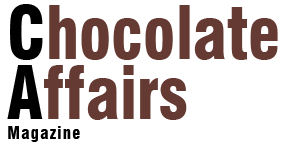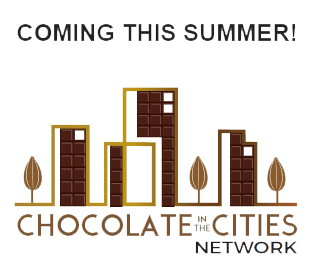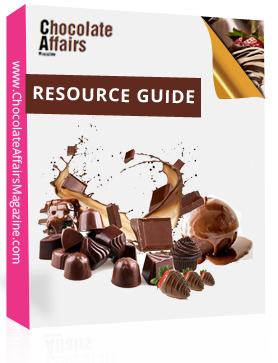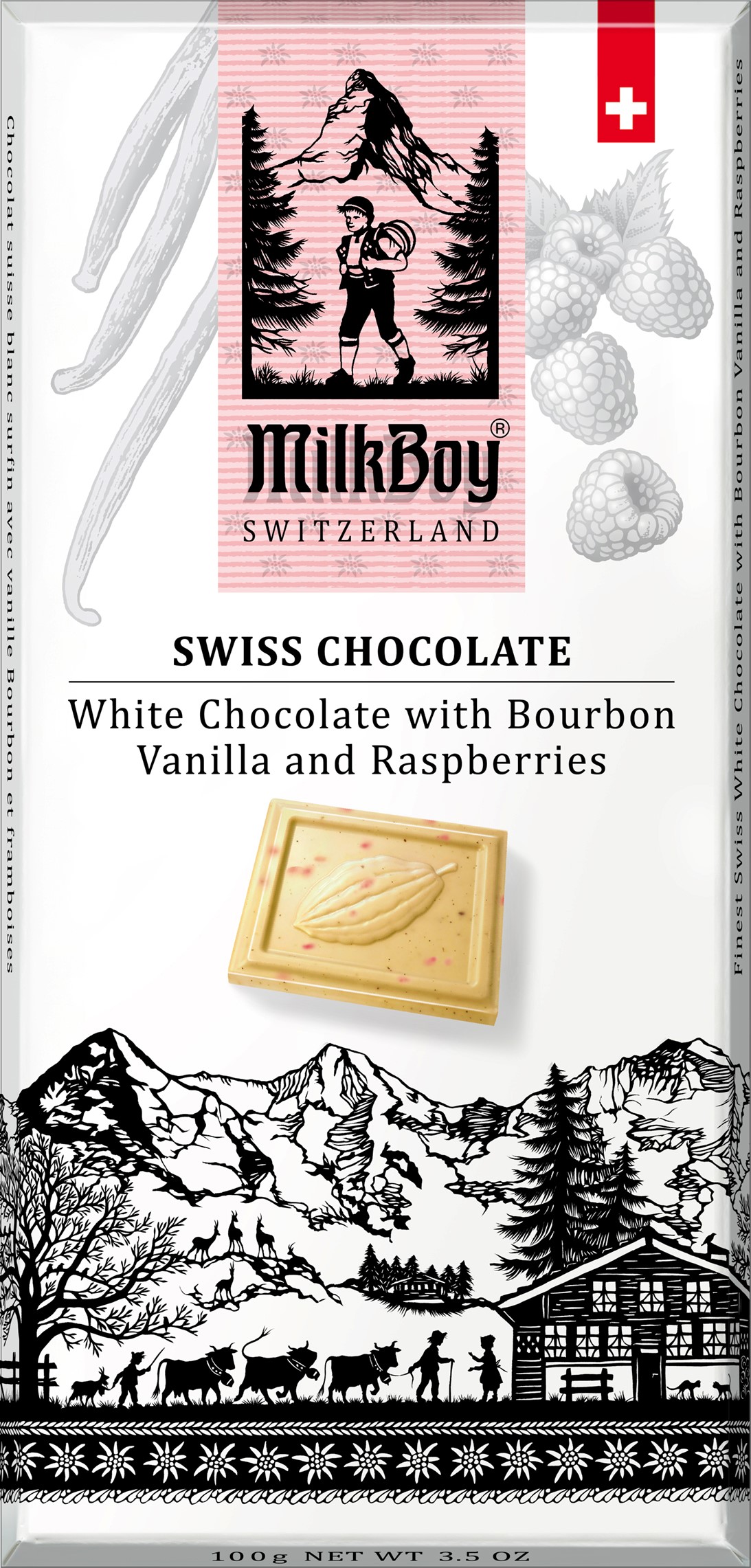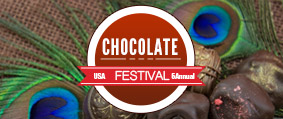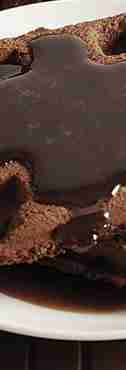WORLD CHOCOLATE ATTRACTIONS
COLOGNE CHOCOLATE MUSEUM
4000 Years Of Chocolate Cultural History
- – A Magnificently Tasty Tour –
Cologne, Germany
It lays here – a ship made of glass and metal alike – in the Rheinauharbour, directly in front of the old town, near the Cologne Cathedral. In medieval times in Cologne, the anchor and terminal was located here by the Rhine boatmen. Today the old swing bridge has been renovated to the new designed harbour quarter of the “Rheinauhafen”. The tour of the nine exhibition areas is a fantastic and unforgettable journey through the 43,000 square feet of the culture and history of chocolate, starting at the old American cultures such as the Maya and the Aztecs, through the Baroque age and the industrialization up to the individual refinement of the noble chocolate of today.
The first and only Chocolate Museum of its kind in the world was opened in the heart of Cologne on October 31,1993. The Chocolate Museum, looking like a ship made of glass and metal, was the first new building in the city’s new “Rheinauhafen“ development area – a high point of urban creativity in the city on the Rhine.
With its 43,000 square feet of floor space, the museum is devoted to the history and present day developments in the world of “chocolate and cocoa”. The activities of the museum include not only the presentation of attractive displays and exhibitions, but also the collection and preservation of objects and artifacts as well as research into the history of chocolate.
By the time of its 20th birthday on October 31, 2013, the museum was visited by more than 10 million people from all over the world, interested in exploring the secrets of chocolate. In 2012 alone, the museum was visited by around 2,300 people on average every day, adding up to a record number of 690,000 visitors for a full year. This puts the Chocolate Museum among the ten most popular mu- seums in Germany.
A Quick Tour Of The Museum
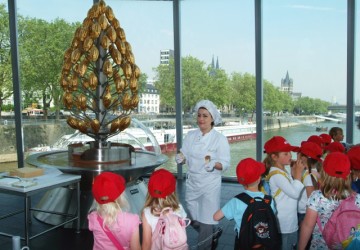
A tour of the museum starts in the four newly created exhibition rooms. These focus on the cultivation and harvesting of cocoa, the cocoa-producing countries, the trade in cocoa, and the effects of chocolate on the body and soul.
In the Tropical House, with its roof rising to a height of 33 ft. visitors suddenly find themselves in the rain forest. The machines in the glass Chocolate Factory allow visitors to see for themselves how chocolate bars, hollow figures or pralines are made today. In this scaled-down version of a full-size production plant, around 400 kg of chocolate are produced every day, and everyone can sample the outcome at the museum’s trademark feature: the 10 ft. tall Chocolate Fountain.
The museum’s “treasure chamber” presents pre-Columbian Central America, with the culture of the Olmecs, Mayas and Aztecs for whom cocoa truly was a “drink of the gods”.
Table services specially made of china and silver for drinking chocolate are evidence of the luxury status enjoyed by chocolate at the courts of Europe in the 17th and 18th centuries, and provide a picture of aristocratic life during that period.
Old advertising commercials provide an entertaining view of how zeitgeist and fashions change. In a nostalgic tour of chocolate advertising from the early 20th century, there are lots of attractive advertising and packaging ideas as well as fascinating vending machines to discover.
The third level is devoted to “Cult Chocolate”. The display centres around the Lindt Gold Bunny, Mars, Ritter Sport, the Surprise Egg, the Mozartkugel, Sarotti, the HallorenKugel, Milka and Nutella, alongside many other products.
The Event Museum
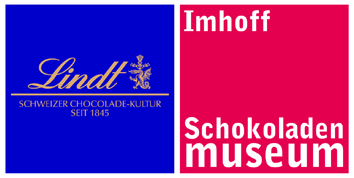
The special thing about the Chocolate Museum is that its theme can not only be seen, but also felt, smelled and tasted!
The event character of the museum is underlined by the nature of the presentation: the sensual aspects of the exhibition theme are heightened by darkened exhibition rooms in which objects are picked out by spotlight, or elements that play with the visitors’ curiosity. Other event elements are the walk-through Tropical House, the production plant and the Chocolate Cinema. The “Cult Chocolate” level, contain a variety of playful and interactive elements that invite people to learn and experience for themselves.
For visitors who want to concern themselves more deeply with chocolate and everything to do with it, the museum offers a wide range of guided tours. Another highly popular feature are the workshops for children and adults where they can invent their own chocolate creations or make their own chocolate pralines.
Visitors Are Guests
The Chocolate Museum is a place where visitors are received and looked after as guests: Consequently, there are no security personnel in the conventional sense to be found at all. Instead, there are around 50 students from various disciplines who not only perform surveillance duties but also act as professionally trained museum guides, able to look after the guests in thirteen different languages. But also the 85 or so other personnel working in production, the restaurant, the Chocolate Shop and the administration also play their part in making more than 80 % of visitors say: “I will come again!” (according to the visitor survey).
The sheer number of visitors (totalling 690,000 in 2007) is impressive proof of the popularity of the Chocolate Museum with the public.
The Architecture

With the opening of the Chocolate Museum in Rheinauhafen, all parties involved had achieved something of a miracle: The complex, with its net floor space of 6,610 square metres and costing over 30 million US dollars, was completed in the extremely short construction time of only 13 months.
“It was agreed in consultation with the architectural conservation authorities right from the start that the new complex should be clearly distinct from the old building,” stated architect Professor Fritz Eller at the inauguration ceremony. It was therefore decided to create a transparent building using large quantities of aluminium and glass and framing the old Customs Building.
As well as the exhibition areas, it was also necessary to design a production shop for the glass Chocolate Factory. This was built right at the tip of the Rheinau peninsula, as if on a great ship’s deck.
This building, extending over two floors and with a total floor space of more than 14,000 square feet, also provides the complex as a whole with an attractive promenade deck, accessed by two broad outdoor staircases. Visually, this underlines the impression made by the museum as being the “first ship” in Rheinauhafen.
4000 Years Of Chocolate Cultural History
The Chocolate Museum takes visitors on a journey of exploration through the 4000-year cultural history of chocolate.
Around 43,000 square feet of exhibition space are devoted to displaying objects that have to do with the origins, history and cultural history of chocolate. Altogether, including the literature and graphics sections, the collection comprises some 100,000 items.
A tour of the museum leads first to the exhibition spaces that were newly designed in March 2012:
Cultivation & harvesting, trade in cocoa and ingredients of chocolate: The first room is dedicated to the botany of the cocoa tree. There are various installations dealing with the rain forest and the distribution of cocoa.
A special feature is the possibility for visitors to try their skills as a gardener: Visitors can send a virtual cocoa tree by email from the museum to their own home, where they then have to tend it. And if they forget to do so, they have no hope of harvesting anything.
Cocoa is by no means just cocoa: Worldwide, there are 20 wild species, and the flavour differs as widely as between different kinds of grapes. The name of the main variety is “Theobroma cacao” – and this botanical name already reveals the secret, as “Theobroma” means “food of the gods”. A number of these divine fruits – embedded in extreme climatic conditions comparable to those in the hot, humid regions of the tropics – can be seen in Cologne. The museum’s Tropical House contains not only various cocoa trees – e.g. the main variety “Theobroma cacao” or the decorative “Theobromagrandiflorum” with its big flowers – but also palm trees, vanilla and coffee plants, and a banana tree. Around 60 species of smaller rain forest plants are also contained in this jungle, through which visitors can “fight their way” on two different levels.
An interesting new resource here is the installation of a video camera so that the tropical plants – cocoa, coffee and banana – can also be admired from outside.
The second room takes a detailed look at various varieties of cocoa and at life and work in the cocoa-growing regions. The audio station in this room allows visitors to learn what a day in the life of a cocoa farming family looks like from the point of view of the father, the mother and the 11 year old daughter.
The next room describes how cocoa reaches us and how the trade in it is conducted. A special feature in this room is the live ticker tape that constantly shows the latest cocoa price. Any visitor wanting to concern themselves with the subject of cocoa trading more intensively can do so in the cocoa market game.
The displays in the fourth and last room are concerned with cocoa and its effects on body and soul. A fascinating anatomical model shows what substances contained in cocoa act on which part of the body and in what way.
A further role is played by the components of chocolate and the chocolate spices. An old factory station invites all visitors – young or old – to test their sense of smell.
On the lower level, visitors will also find the Chocolate School. Especially for children taking part in guided tours, the individual production steps are described in this quiet, separate room, supported by small tasting samples of the various ingredients. The motto of the Chocolate School is: Don’t just listen, join in!
Chocolate Production

Chocolate was, and is, a highly processing-intensive product. Mechanical techniques therefore already began at an early age to play an important role. Heinrich Stollwerck made a name for himself as an important engineer and inventor, who manufactured his machines himself. A five-roll machine from the year 1873 which he developed and patented and in which the chocolate mass was refined through being passed over granite rollers can be seen in the museum.
Right next to it is a painstakingly restored cocoa butter press that was originally developed by Van Houten. This machine was used for pressing the butter out of the cocoa beans, enabling the cocoa butter and the cocoa mass to be separated and e.g. cocoa powder to be made from the fat-free cocoa mass. How this is done today using modern machinery can be seen in the production area, which is accommodated in the “bow” of the ship-like museum building where the Chocolate Fountain also stands.
There is, indeed, no way of getting past the Chocolate Fountain, a structure that was designed specially for the museum and holds 200 kilograms of warm, liquid chocolate. This attraction was made by mechanical engi- neer Heinz Huiskens, to designs of Professor Fritz Eller, the museum’s architect, and his partner Robert Walter. Out of four stainless steel fountains, liquid warm chocolate flows into the fountain’s basin, into which wafers are dipped by museum staff and handed to the visitors.
As well as the Chocolate Fountain, the production area also houses a complete unit for processing cocoa, right through from roasting, breaking and grinding of the beans to the mixed, rolled and conched chocolate mass. A plant for making chocolate bars as well as the truffle and hollow figure production facilities give some idea of the delicious products that chocolate can be made into. Some 400 kg of chocolate are processed every day in this scaled-down version of a full-size chocolate processing plant.
From The Cult Drink Of The Mayas And Aztecs to a Product For Everyone
The museum’s ”Treasure Chamber” takes a look at pre-Columbian Mesoamerica – the culture of the Olmecs, Mayas and Aztecs, for whom cocoa, which over the centuries sometimes also served as a currency, was a “drink of the gods”. The exhibits, some of which are extremely rare, clearly indicate how important cocoa was to these peoples and how they prepared it for consumption. The ob- jects include sculptures,artifacts used during ritual acts, Maya scripts, drinking vessels and many more items.
When the new hot drink known as chocolate gradually began to conquer Europe in the 17th and 18th centuries, table services were specially made of precious materials such as china and silver to enable the chocolate to be drunk in the appropriate style. Chocolate cups and pots illustrate the exclusive nature of this luxury article and provide an indication of the life lived by the aristocracy of the time, which was characterised by cultured idleness.
The story of how chocolate developed from a luxury item for the few into a product that can be enjoyed by everyone is told in the last room of the cultural history section: As a result of industrialisation and colonialism, chocolate became a pleasure article that could be afforded by large sections of the population. The cultural history of chocolate in the 19th and 20th centuries is brought to life by two historical shop interiors and old cocoa and chocolate product wrappers with their ornate designs.
The “Cult Chocolate” Exhibition Level
What makes an object a cult object?
Typical of cult objects is that they give identity and are seen by many as being especially typical of their time. With certain objects, we associate special memories or emotions. These objects usually have an extraordinary design and are to some extent independent of contemporary fashion. In many cases, it is the cult objects themselves that actually set the trends. All of this is true of the “Cult Chocolate” products on display in this room, which are divided into various theme areas, i.e. Nature & Animals, Affection & Gratitude, Pleasure and Relaxation, Men & Sport and Children & Fantasy.
The exhibition centres on the Lindt Gold Bunny, the LindorKugel, Mars, Ritter Sport, the Surprise Egg, the Mozartkugel, Sarotti, the HallorenKugel, Milka, Nutella, Scho-Ka-Kola, Hershey’s Kisses and many other products.
However, as well as the history of the individual brands, this section also contains anecdotes, entertaining and curious facts, and also some fascinating games.
Chocolate Vending Machines
A look back at the early history of advertising and sales promotion is provided by some 30 magnificent chocolate vending machines that could already be found in the 19th century at railway stations, in New York, on the Zugspitze in Bavaria or the Champs-Elysées in Paris, as well as a collection of historical posters, enamel signs, and collecting cards and albums.
In the Chocolate Cinema, you can see “sweet” advertising commercials from 1926 to today.
Company Histories
A whole section is dedicated to the history of the entrepreneur Dr. Hans Imhoff, who founded the Chocolate Museum, and the Lindt & Sprünglicompany, which since March 2006 has been the Museum’s cooperation partner.
The entrepreneur Dr. Hans Imhoff, who was born in Cologne in 1922, was granted a permit in 1945 to set up a food wholesale business. Proceeding from this business base, he began to expand increasingly in the course of the years, taking over various other firms. His arguably biggest success was the takeover in 1971/72 of the then ailing firm of Stollwerck. Additionally, following the reunification of Germany, he was one of the first businessmen to invest in Eastern Germany and Eastern Europe.
After a successful exhibition in the city’s Gürzenich building, he decided to give the Chocolate Museum to his native city. The basis for the continually growing collection of exhibits on the history of chocolate were old wrappers, advertising signs, vending machines etc. Hans Imhoff, initiator of the Imhoff Foundation and honorary citizen of the City of Cologne, died in December 2007.
Lindt & Sprüngli: In 1845, David Sprüngli-Schwarz, a confectioner, produced chocolate in solid form for the first time. With his so-called “conche”, RudolpheLindt developed a new processing method in 1879 that is still the secret of smooth chocolate as we know it today. In 1899, Sprüngli acquired Lindt, and with it the production plant in Bern and the secret of how to make smooth chocolate.
Today, Lindt & Sprüngli AG produces chocolate in Switzerland, Germany, France, Italy, Austria and the USA.
As a manufacturer of quality chocolate products, the company benefits from the general trend towards high- quality chocolate.
March 23,2006 saw the start of the cooperation between the Swiss chocolate maker Lindt & Sprüngli and the world’s only Chocolate Museum in the fields of production and marketing. Since that date, the chocolate production has been under the direction of the firm of Lindt.
Various guided tours are also offered for groups of children and school students. With the aid of the museum’s educational active programmes, school student groups can also deal with various chocolate-related topics by themselves.
Museum Education
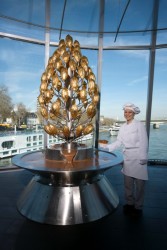
The museum has its own educational expert who is responsible for the conception of the guided tours and materials, special programmes and workshops for children and adults, and the regular initial and further training of the museum guides.
Information on all the guided tours, workshops and special programmes for children and adults as well as the possibilities for celebrating children’s birthdays in the museum can be found on the museum website.
The Chocolate Shop
For those whose appetite has been whetted by their tour of the museum, the Chocolate Shop offers a broad selection of top-quality chocolate products, postcards, souvenirs and other gift ideas.
The “Grand Café Chocolat”
The museum Café, which offers a magnificent view of the Rhine, has become a favourite meeting place. In summer and winter alike, visitors can also enjoy the view and the hot and cold dishes on the Terrace!
MUSEUM HOURS
Tuesday to Friday: 10:00 am – 4:00 pm
Saturday/Sunday/Bank Holidays: 11:00 am – 6:00 pm
In 2016 the museum will be open on following Mondays:
• March 21
• Every Monday in July and August
• October 10, 17 and 31st
• Every Monday in December The museum will be closed all other Mondays.
Last admission 1 hour before closing time. The production facilities close 30 minutes earlier than the Chocolate Museum.
Visit on-line at
www.chocolatemuseum-cologne.com
